
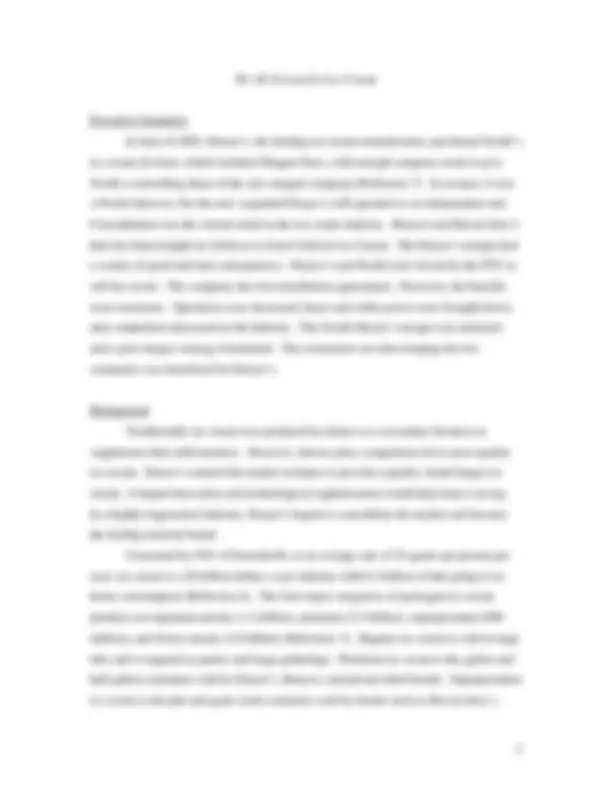
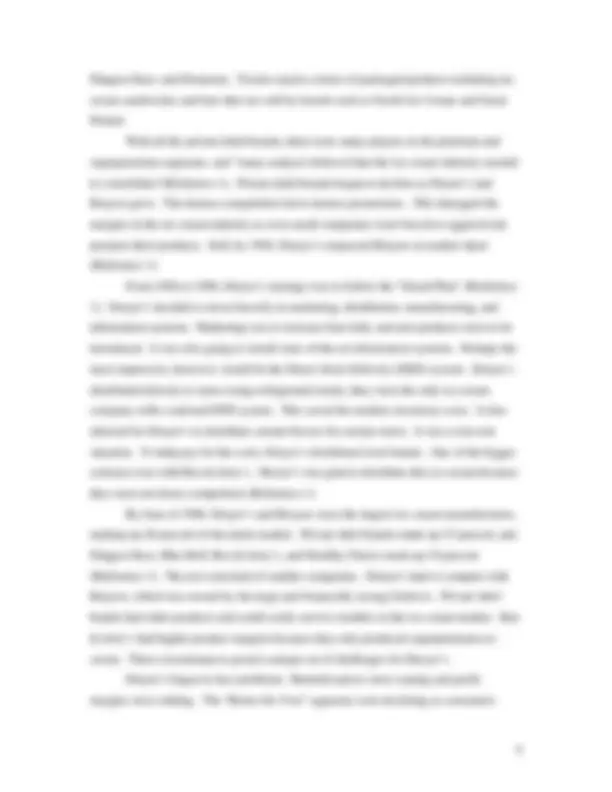
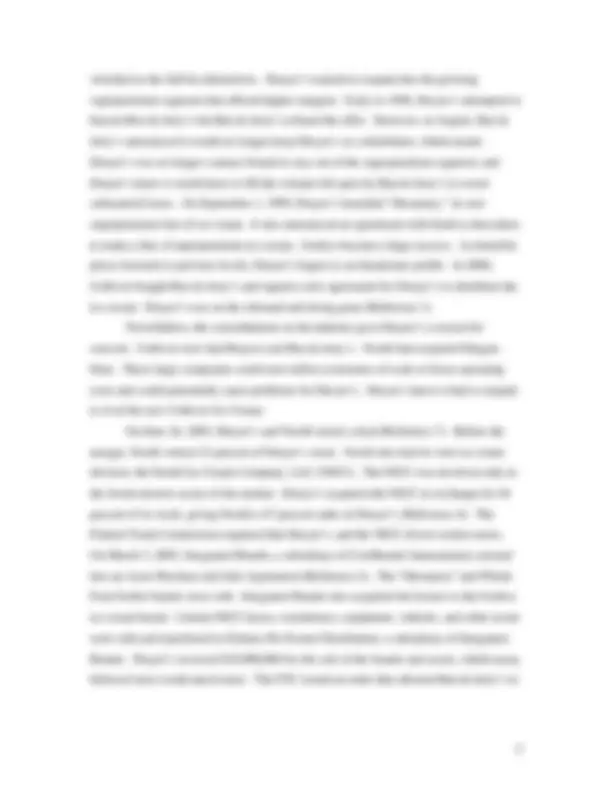
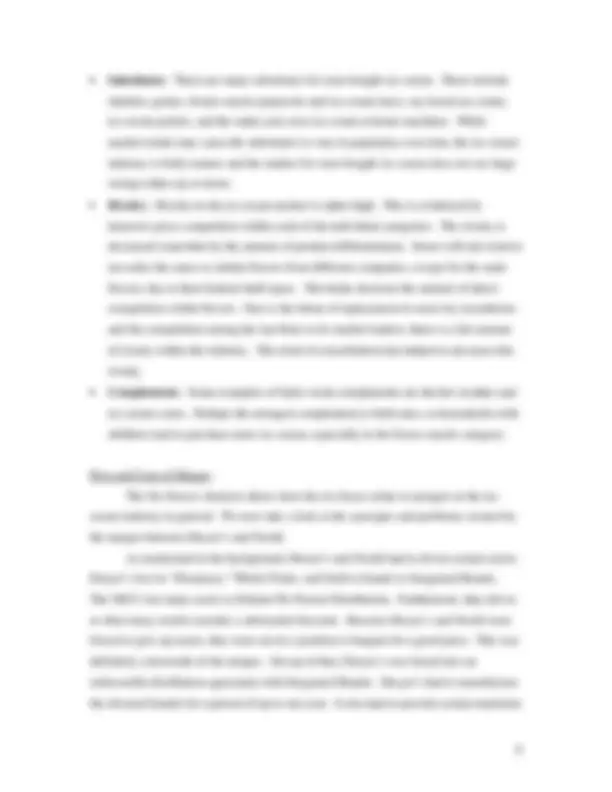
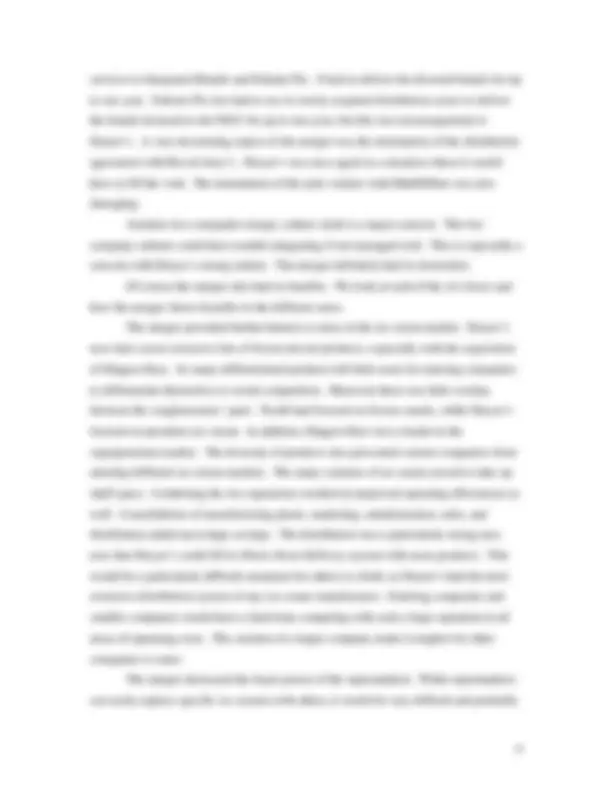
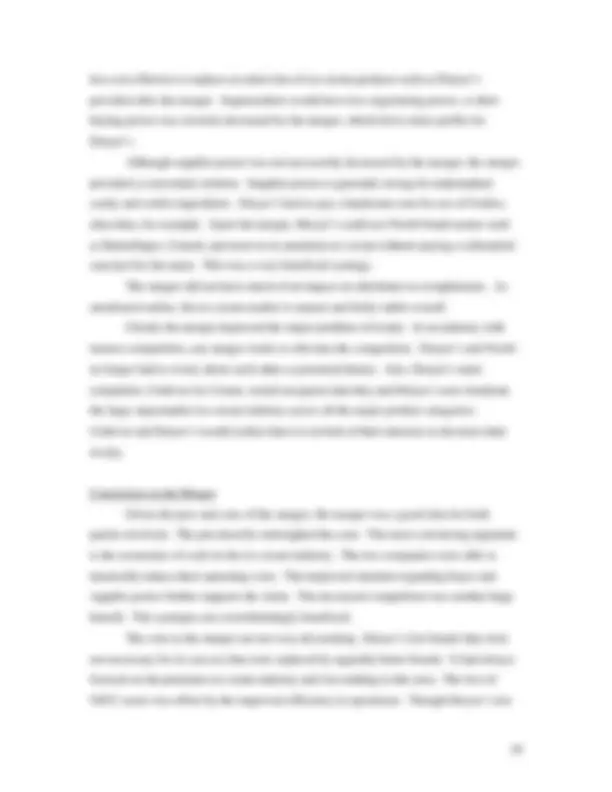
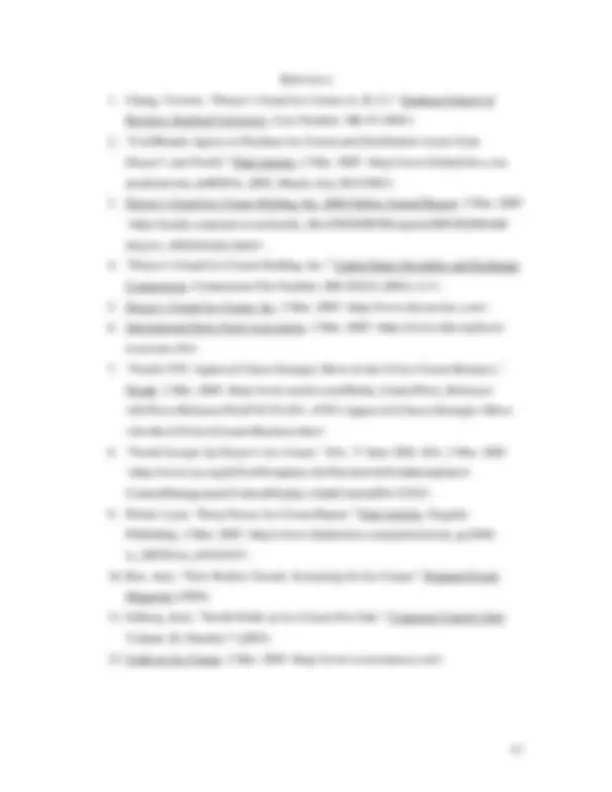
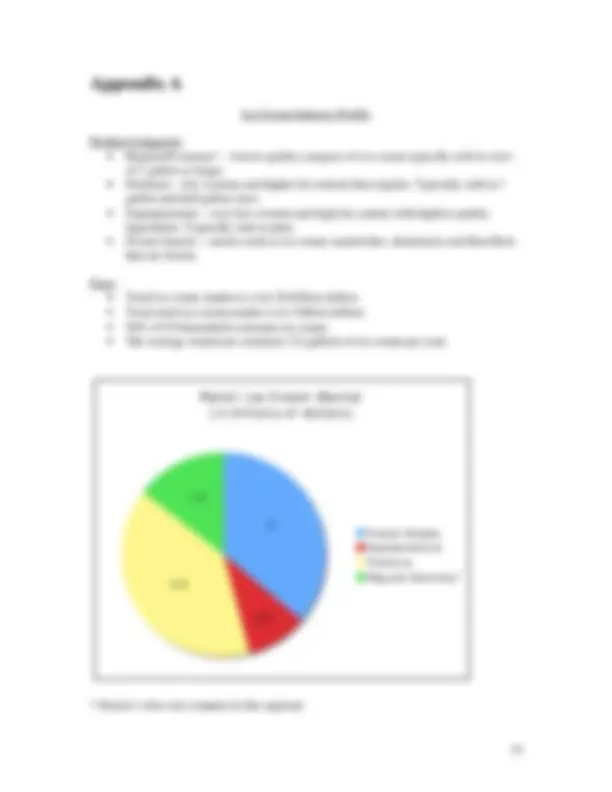
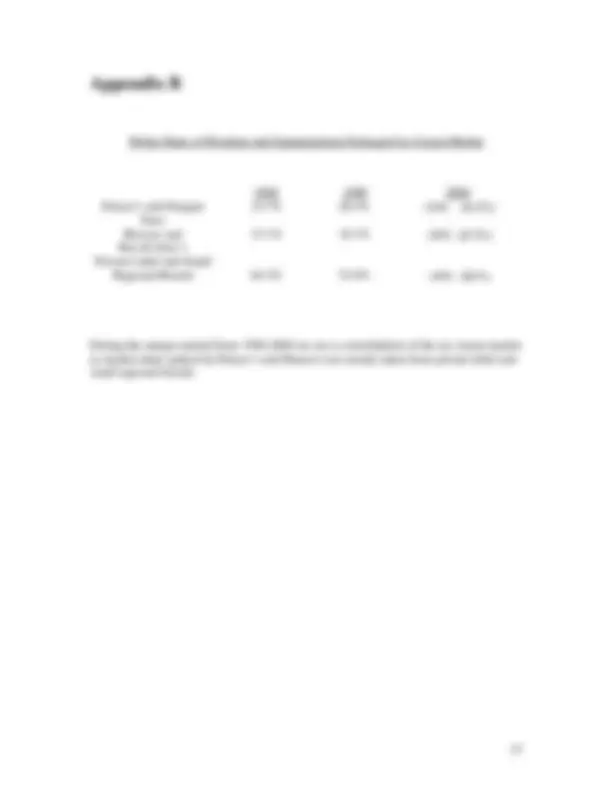


Study with the several resources on Docsity

Earn points by helping other students or get them with a premium plan


Prepare for your exams
Study with the several resources on Docsity

Earn points to download
Earn points by helping other students or get them with a premium plan
Community
Ask the community for help and clear up your study doubts
Discover the best universities in your country according to Docsity users
Free resources
Download our free guides on studying techniques, anxiety management strategies, and thesis advice from Docsity tutors
Total retail ice cream market is 8.3 billion dollars. 94% of US household consume ice cream. The average American consumes 5.6 gallons of ice ...
Typology: Study notes
1 / 17

This page cannot be seen from the preview
Don't miss anything!










Dean Reich Ruxandra Paun Scott Davies McAfee BEM 106 1 June 2005
Häagen-Dazs, and Dreamery. Frozen snacks consist of packaged products including ice cream sandwiches and bars that are sold by brands such as Nestlé Ice Cream and Good Humor. With all the private label brands, there were many players in the premium and superpremium segments, and “many analysts believed that the ice cream industry needed to consolidate”(Reference 1). Private label brands began to decline as Dreyer’s and Breyers grew. The intense competition led to intense promotions. This damaged the margins in the ice cream industry as even small companies were forced to aggressively promote their products. Still, by 1994, Dreyer’s surpassed Breyers in market share (Reference 1). From 1994 to 1998, Dreyer’s strategy was to follow the “Grand Plan” (Reference 1). Dreyer’s decided to invest heavily in marketing, distribution, manufacturing, and information systems. Marketing was to increase four-fold, and new products were to be introduced. It was also going to install state-of-the-art information systems. Perhaps the most impressive, however, would be the Direct-Store-Delivery (DSD) system. Dreyer’s distributed directly to stores using refrigerated trucks; they were the only ice cream company with a national DSD system. This saved the retailers inventory costs. It also allowed for Dreyer’s to distribute certain flavors for certain stores. It was a win-win situation. To help pay for the costs, Dreyer’s distributed rival brands. One of the bigger contracts was with Ben & Jerry’s. Dreyer’s was glad to distribute this ice cream because they were not direct competitors (Reference 1). By June of 1998, Dreyer’s and Breyers were the largest ice cream manufacturers, making up 28 percent of the entire market. Private label brands made up 23 percent, and Häagen-Dazs, Blue Bell, Ben & Jerry’s, and Healthy Choice made up 18 percent (Reference 1). The rest consisted of smaller companies. Dreyer’s had to compete with Breyers, which was owned by the large and financially strong Unilever. Private label brands had other products and could easily survive troubles in the ice cream market. Ben & Jerry’s had higher product margins because they only produced superpremium ice cream. These circumstances posed a unique set of challenges for Dreyer’s. Dreyer’s began to face problems. Butterfat prices were soaring and profit margins were sinking. The “Better-for-You” segments were declining as consumers
switched to the full-fat alternatives. Dreyer’s wanted to expand into the growing superpremium segment that offered higher margins. Early in 1998, Dreyer’s attempted to buyout Ben & Jerry’s but Ben & Jerry’s refused the offer. However, in August, Ben & Jerry’s announced it would no longer keep Dreyer’s as a distributor, which meant Dreyer’s was no longer contract bound to stay out of the superpremium segment, and Dreyer’s knew it would have to fill the volume left open by Ben & Jerry’s to avoid substantial losses. On September 1, 1999, Dreyer’s launched “Dreamery,” its new superpremium line of ice cream. It also announced an agreement with Godiva chocolates to make a line of superpremium ice cream. Godiva became a huge success. As butterfat prices lowered to previous levels, Dreyer’s began to see handsome profits. In 2000, Unilever bought Ben & Jerry’s and signed a new agreement for Dreyer’s to distribute the ice cream. Dreyer’s was on the rebound and doing great (Reference 1). Nevertheless, the consolidations in the industry gave Dreyer’s a reason for concern. Unilever now had Breyers and Ben & Jerry’s. Nestlé had acquired Häagen- Dazs. These large companies could now utilize economies of scale to lower operating costs and could potentially cause problems for Dreyer’s. Dreyer’s knew it had to expand to rival the new Unilever Ice Cream. On June 26, 2003, Dreyer’s and Nestlé struck a deal (Reference 7). Before the merger, Nestlé owned 23 percent of Dreyer’s stock. Nestlé also had its own ice cream division, the Nestlé Ice Cream Company, LLC (NICC). The NICC was involved only in the frozen deserts sector of the market. Dreyer’s acquired the NICC in exchange for 44 percent of its stock, giving Nestlé a 67 percent stake in Dreyer’s (Reference 8). The Federal Trade Commission required that Dreyer’s, and the NICC divest certain assets. On March 3, 2003, Integrated Brands, a subsidiary of CoolBrands International, entered into an Asset Purchase and Sale Agreement (Reference 2). The “Dreamery” and Whole Fruit Sorbet brands were sold. Integrated Brands also acquired the license to the Godiva ice cream brand. Certain NICC leases, warehouses, equipment, vehicles, and other assets were sold and transferred to Eskimo Pie Frozen Distribution, a subsidiary of Integrated Brands. Dreyer’s received $10,000,000 for the sale of the brands and assets, which many believed were worth much more. The FTC issued an order that allowed Ben & Jerry’s to
industry as well as established reputations for major companies. Another barrier is the limited access to major distribution channels. To be a national brand, a company needs to have the ability to keep their product frozen and distribute it. This either takes a large investment to establish, or the company can become a partner brand with a large competitor that has a distribution system in place. This allows the distributor to profit and keep the company in check with the threat of dropping them if they become too competitive. This also causes the company to become dependent on the distributor. In order to become a competitor with a company like Dreyer’s, a company must overcome these entry barriers.
Pros and Cons of Merger The Six Forces Analysis shows how the six forces relate to mergers in the ice cream industry in general. We now take a look at the synergies and problems created by the merger between Dreyer’s and Nestlé. As mentioned in the background, Dreyer’s and Nestlé had to divest certain assets. Dreyer’s lost its “Dreamery,” Whole Fruits, and Godiva brands to Integrated Brands. The NICC lost many assets to Eskimo Pie Frozen Distribution. Furthermore, they did so at what many would consider a substantial discount. Because Dreyer’s and Nestlé were forced to give up assets, they were not in a position to bargain for a good price. This was definitely a downside of the merger. On top of that, Dreyer’s was forced into an unfavorable distribution agreement with Integrated Brands. Dreyer’s had to manufacture the divested brands for a period of up to one year. It also had to provide certain transition
less cost effective to replace an entire line of ice cream products such as Dreyer’s provided after the merger. Supermarkets would have less negotiating power, so their buying power was severely decreased by the merger, which led to more profits for Dreyer’s. Although supplier power was not necessarily decreased by the merger, the merger provided a convenient solution. Supplier power is generally strong for trademarked candy and cookie ingredients. Dreyer’s had to pay a handsome sum for use of Godiva chocolate, for example. Upon the merger, Dreyer’s could use Nestlé brand names such as Butterfinger, Crunch, and more in its premium ice cream without paying a substantial sum just for the name. This was a very beneficial synergy. The merger did not have much of an impact on substitutes or complements. As mentioned earlier, the ice cream market is mature and fairly stable overall. Clearly the merger improved the major problem of rivalry. In an industry with intense competition, any merger works to alleviate the competition. Dreyer’s and Nestlé no longer had to worry about each other as potential threats. Also, Dreyer’s main competitor, Unilever Ice Cream, would recognize that they and Dreyer’s now dominate the large supermarket ice cream industry across all the major product categories. Unilever and Dreyer’s would realize that it is in both of their interests to decrease their rivalry.
Conclusion on the Merger Given the pros and cons of the merger, the merger was a good idea for both parties involved. The pros heavily outweighed the cons. The most convincing argument is the economies of scale in the ice cream industry. The two companies were able to drastically reduce their operating costs. The improved situation regarding buyer and supplier power further supports the claim. The decreased competition was another huge benefit. The synergies are overwhelmingly beneficial. The cons to the merger are not very devastating. Dreyer’s lost brands that were not necessary for its success that were replaced by arguably better brands. It had always focused on the premium ice cream industry and lost nothing in this area. The loss of NICC assets was offset by the improved efficiency in operations. Though Dreyer’s lost
these for little compensation, the increased profits due to the merger made it worth the hit. The unfavorable distribution agreements with Integrated Brands were only temporary. The loss of Ben & Jerry’s was not as crucial as the first time. Dreyer’s would easily be able to fill the distribution void with Nestlé and Häagen-Dazs products and new Dreyer’s products. Ben & Jerry’s business was not necessary. The severance of the venture with M&M/Mars was a minor inconvenience compared to the new joint venture created. The downsides were temporary and minor in comparison to the rewards. Dreyer’s is now the number one ice cream manufacturer. It holds 24 percent of the market while Breyers holds 20 percent (Reference 5). Its profits are soaring, and it is in a position to remain at the top for years to come. Also, during this period of major consolidation from 1998 to 2003, the ice cream industry grew by a remarkable 24% in revenues (Reference 10).
Post-merger Strategy As a larger, merged ice cream company, Dreyer’s will have to make changes and adaptations to realize the full benefits of the merger. Within the structure of the larger company, they have the challenge of aligning the employees based on business objectives and company cultures. They must utilize all the potential synergies and economies of scale created. They can consolidate resources such as equipment, property, talent, and delivery methods just to name a few. They must step into their new leadership role signaling to Unilever that they are ready to decrease industry rivalry. The new expanded line of products should be marketed to supermarkets so that outlets that carried Dreyer’s but not Häagen-Dazs for instance would have an incentive to add those products and kick competitors off the crowded shelves. Flavor selection and product variety should continue to expand as well to further crowd up the shelf space and decrease competition by greater product differentiation. One possible way of doing this would be to add Nestlé candy bar flavors to the Dreyer’s premium ice cream product. Also, they should phase out unpopular and overlapping brands. In these ways the merger can be utilized to add value to the combined company. Also, to remain the industry leader, Dreyer’s needs to continue to do several things well. They must continue to innovate in taste, packaging, and flavor selection.
References
Ice Cream Industry Profile
Product Categories
Facts
Retail Ice Cream Market (in billions of dollars)
(^3) Frozen Snacks Superpremium Premium Regular/Economy*
Dreyer's Products
Toll House Cookie Sandwich
Drumstick
Crunch Bar
Butterfinger bar
Bon Bons
Carnation
Dole Popsicles
Skinny Cow Snacks
Push-Up
Silhouette
Appendix D